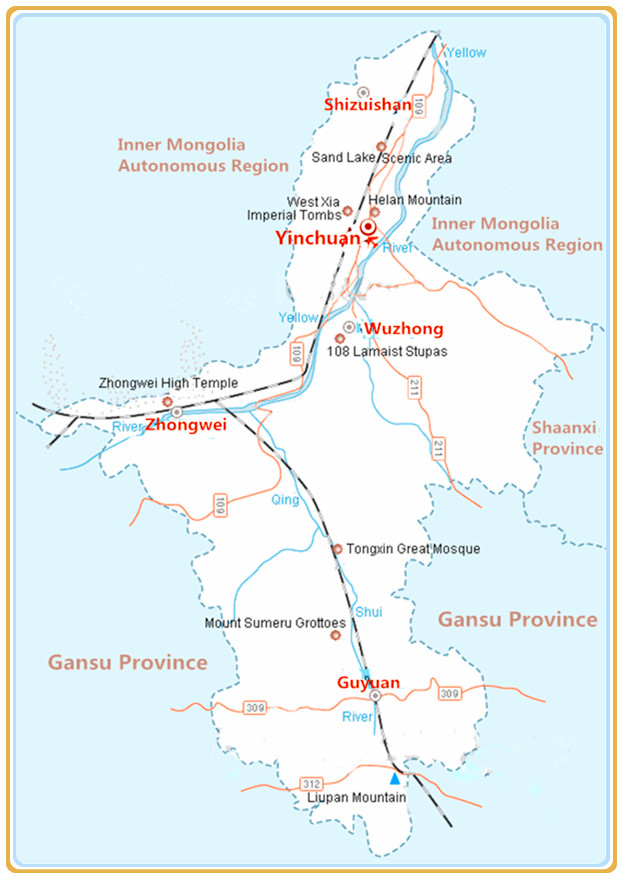Skype: neodalle-travel
Tel: +86 135 7447 2266
E-mail: sales@visitaroundchina.com
 Ningxia Hui Autonomous Region is one of the five autonomous regions in China. It is the only provincial-level ethnic Hui region and the best place to experience the country's Muslim culture. The capital, Yinchuan, is not only the political, economic, and cultural center of the region, but also a famous historical and cultural city.
Ningxia Hui Autonomous Region is one of the five autonomous regions in China. It is the only provincial-level ethnic Hui region and the best place to experience the country's Muslim culture. The capital, Yinchuan, is not only the political, economic, and cultural center of the region, but also a famous historical and cultural city.History of Ningxia
Ningxia, a region as culturally rich as the entire area south of the Yangtze River, continues to be admired for its resplendent cultural heritage garnered from the long river of history. Ningxia witnessed human activities as far back as some 30,000 years. Archaeological excavations have unearthed stone and bone ware and evidence of the use of fire in the cultural relics of the Paleolithic Age in Shuidong Gauge of Lingwu County-Level City. During the time of the Tang and Han Dynasties (206 BC - 907 AD) Ningxia was the main place for trade and transportation between the eastern and western regions of ancient China. Ruins of the Great Wall of the Ming Dynasty can be found in its east region. ..Ningxia History
Geography of Ningxia
Ningxia is located on the northwest Loess highlands pierced by the Yellow River. The Great Wall runs along its northeastern boundary. Ningxia borders Gansu Province to the south, Shaanxi to the east and the Inner Mongolia Autonomous Region to the north. It is a relatively arid region, including the Tengger desert in Shapotou, but the ancient Yellow River irrigational system ensures the northern part is well watered – earning it the nickname of the ‘land of fish and rice’ in the North.
Climate of Ningxia
Ningxia has a temperate continental climate of long, cold winters and short, hot summers; temperature is lowest in January, averaging from -10 to -7 degrees Celsius and highest in July, averaging from 17 to 24 degrees Celsius. Annual rainfall averages from 190-700 millimeters.
Diversity of Ningxia
Ningxia is home to Hui people who make up about 36 percent of the regional population of 6 million and Hui people mostly live in Tongxin, Guyuan, Xiji, Haiyuan and Jingyuan counties as well as Wuzhong City and Lingwu County irrigated with water diverted from the Yellow River. There are also many other ethnic minority groups in the region.
Economy of Ningxia
Ningxia has one of biggest pastures in the country. It boasts rich mineral resources, such as sodium, magnesium, ammonia, lime nitrogen, tantalum and niobium. The Shan Gan Ning Natural Gas Field is one of the largest in the world. Its GDP in 2018 was 3705.18 billion yuan (US$529.3 billion), with a per capita GDP of 54,094 yuan (US$7,727). Ningxia is the principal region of China where wolfberries are grown.
Ningxia Tourism
A unique landscape, unique local customs and habits, and ancient history, all add up to make Ningxia an interesting tourist area for those wishing to discover a rich and diverse region. Yinchuan City is a famous cultural city beyond the Great Wall. The major attractions in Ningxia include the 1500-year-old Haibao Pagoda; the famous Buddhist architecture from the West Xia Kingdom Pagoda of Chengtian Temple; and the Western Xia Imperial Tombs known as the 'Pyramids of China'. One can also find there the mystic Helan Mountain Rock Painting, created by the ancient nomads who dwelled in the regions of the Helan Mountains in northwest Ningxia. They used a bold and descriptive chiseling and drawing technique, to which they added dazzling colors, to depict the history of a splendid Chinese civilization...Ningxia Attractions
 Ask Questions ?
Ask Questions ?